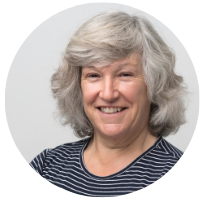Understanding why cancers grow in some tissues and not in others
 Background
Background
The Cancer Grand Challenges SPECIFICANCER team, jointly funded by Cancer Research UK and the Mark Foundation for Cancer Research, were awarded £20 million in 2019 to generate a comprehensive map of cancer drivers and their specificity to different tissues. Professor Elledge and his team are tackling the challenge 'Devise approaches to prevent or treat cancer based on mechanisms that determine tissue specificity of some cancer genes'.
Cancer is caused by mutations in the DNA of our cells. These mutations can come about by chance, or can be caused by environmental factors, and result in cells multiplying out of control. We know that different DNA mutations can cause different types of cancer. For example, mistakes in the BRCA1 and BRCA2 genes are known to have a role in breast and ovarian cancer development. However, despite decades of research, we don’t yet understand why these errors only cause cancer in specific organs, and not in other parts of the body. The faulty genes can be found in nearly all our cells – so why is the cancer found in specific places?
Professor Stephen Elledge and his international team of researchers are stepping up to the plate, and are looking to answer this question once and for all. By carefully mapping cancer drivers in our cells – molecules that are known to cause cancer – they hope to shed light on which drivers cause cancer in different tissues throughout the body.
In a collaboration that involves researchers from multiple disciplines – including geneticists, cell biologists and bioinformaticians – this Cancer Grand Challenges project aims to generate a comprehensive map of cancer drivers and their specificity to different tissues. This has the potential to improve our basic understanding of cancer, and provide information that will impact therapeutic choices for patients.
The research
The team – made up of researchers in the USA and the Netherlands – are going to look at our cells’ DNA to identify which genes control whether cells divide or not. By looking at the DNA in different locations in the body, this screen will allow the team to look at whether certain genes are only active in specific tissues. This will provide vital information on known cancer drivers, as well as allowing the team to identify new potential drivers of cancer. Alongside this, the researchers will be assessing how well different cancer drugs work in different types of cancer, and if this can be linked to the activity of cancer drivers.
The impact
If successful, the SPECIFICANCER team's map of ‘tissue specificity’ will give us a complete overview of which cancer drivers play a role in the different tissues throughout the body. This understanding could transform the way doctors treat cancer, as they will be able to select which drugs are more likely to work based on exactly how and where the cancer originated.
Background
The genomics revolution has offered unprecedented insight in to the pathways that are dysregulated in cancer. A recurrent observation from these studies is that certain mutations are frequently associated with malignancies in specific tissues but are virtually absent from others.
Put another way, tissues show strong preference for different palettes of driver mutations.
How and why this tropism exists remains largely unknown, but it strongly suggests that bottlenecks to tumorigenesis are tissue specific and that the processing of information conferred by driver mutations is dependent on the molecular milieu.
Understanding the mechanisms that underpin the way different tissues respond to mutations is an issue which – if tackled – could transform the way cancers are managed, from prevention through to treatment.
At the heart of the issue lies a fundamental question; what gives a tissue its identity?
Tissue-specific epigenetic landscapes
Stephen Elledge and his team believe that epigenetic architecture assembled during development creates a tissue-specific molecular circuitry which dictates how the information from oncogenic drivers is processed and responded to. As such, they posit that the epigenetic landscape of the cell will confer targetable tissue-specific vulnerabilities.
Cancer Grand Challenges has enabled him to assemble an international constellation of world-leading tumour biologists, geneticists, computational biologists and more to test this hypothesis.
The scale of funding afforded by Cancer Grand Challenges has allowed him to devise an ambitious plan – called SPECIFICANCER – to breach the boundaries of traditional, single investigator-led approaches, and create synergy on an unparalleled scale.
Their overall approach is to integrate data from functional genomic screens, in vivo models and cancer genomics studies to build rich tissue-specific datasets to interrogate why specific responses are evoked following oncogenic mutation.
Permissive versus non-permissive tissues
To flush out genes involved in establishing the cancer phenotype across cell types, the team will embark on a suite of unbiased screens – the largest ever performed in healthy tissue. Oncogenic driver libraries, together with ORF and CRISPR libraries will be used to identify genes driving proliferation and survival in eight different cell types taken from seven (brain, breast, colon, kidney, lung, pancreas and skin) organs.
Promising hits will be further scrutinised with organoid panels – which are amenable to high-throughput oncogenic library screens – allowing the team to validate their results in models which more closely mimic the tumour environment.
To unveil the specific molecular constituents of permissive and non-permissive states, the group will next introduce individual oncogenic mutants (KRAS, HRAS, BRAF, EZH2), or knock-out tumour suppressor genes (APC, SETD2 and PRC2) into an array of different tissue types using an inducible CRISPR system.
These isogenic lines will be subjected to exhaustive transcriptomic (RNAseq), proteomic (whole and phospho-proteome) and epigenetic (ChIP seq and ATAC seq) analyses of cell in the presence or absence of each oncogenic insult.
Next, these genetically engineered cells will be used as the basis for the first ever systematic review of synthetic lethality across human tissues – using both ORF and CRISPR libraries – to identify driver-specific lethals that are tissue-selective or promiscuous across different tissue types.
Finally, commonly observed combinations of driver mutations will be introduced into permissive and non-permissive tissues, which will then be subjected to large-scale compound screens to further delineate targetable tissue-specific vulnerabilities.
Together, these experiments will allow the group to discern the ‘ground-state’ for each different cell type and elucidate how this molecular circuitry is perturbed by driver events.
They’ll also allow the team to see whether re-creating this circuitry in non-permissive tissues could drive transformation and importantly, whether short-circuiting these networks might abort or reverse tumorigenesis.
In vivo veritas
The team will next focus efforts on three pathways which display exquisite tissue-specific mutational profiles in cancer: KRAS/MAPK, WNT/β-Catenin and EZH2/PRC2, the latter of which is itself an epigenetic modifier that is frequently mutated in many tumour types.
Using genetically-engineered mouse models, the aim will be to discern the biological consequences of driver mutations in permissive and non-permissive tissues in well-defined, genetically tractable in vivo settings.
Talk to the tissue
Not only will this project reveal novel tissue-specific targets, its findings might also help explain why certain treatments have therapeutic benefit in some tumor types but fail to do so in others.
In recent years, the idea of treating tumours according to their genetic profile rather than their anatomical site has gained significant traction. But while the hypothesis is solid in principle, it has not yet lived up to its promise in the clinic; targeted treatments have shown wildly different effects in different tissue types, even those with identical driver mutations.
Elledge asserts that these disparities are down to the tissue-specific epigenetic ‘ground-state’ and that the project will provide the rationale for a new era of ‘tropo-genetic’ medicine which considers oncogenic mutations, and crucially, the tissue context in which they exist.
When cartography and biology collide
The vast amounts of data generated will integrated to produce functional maps, which will provide – for the first time – a comprehensive and robust way to compare and interrogate tissue-specific networks.
The team hope that the community will be able to use these maps to provide genomics data into deeper biological context and unveil novel therapeutic strategies that are rooted in the biology of tissues.
Wider impact
The team will generate a number of resources – including cells, organoids, genomic libraries and datasets – all which will be made freely available to the wider community.
Elledge’s team is hopeful that the project will establish a new doctrine for the way tumours are approached both in the lab and in the clinic. Although the project focuses on a subset of cancers, it’s easy to see how lessons learned could percolate across disease types, revealing insights into how cancer develops and might be targeted.
But it’s not only cancer research that is likely to be enriched by this work. By offering a tissue-specific lens through which to view cell behaviour, this project has the potential to drive innovation and discovery across the field of metazoan biology. As Elledge himself predicts: “It’s going to make a lot of things possible that weren’t before.”
 Debbie Lennard, Cancer Grand Challenges Advocacy Panel
Debbie Lennard, Cancer Grand Challenges Advocacy Panel
"All the Cancer Grand Challenges applications were exciting and had huge potential to help understand and beat cancer quicker, but this application stood out.
They are a strong team of researchers and patient representatives who want to learn more about how genes and organ tissues interact.
This will teach us a lot about cancer prevention and more effective, but less invasive, cancer treatment. This has the potential to touch so many peoples’ lives. "
Professor René Bernards introduces Professor Steve Elledge's Cancer Grand Challenge

We are thrilled to be involved with Cancer Grand Challenges. Understanding the fundamental basis of tissue specificity in cancer is central to generating the most systematic approach to selecting therapies. Cancer Grand Challenges provides us with the resources to assemble the right team to unravel this riddle and to ensure we are best matching cancer types to the therapies that are most likely to benefit the patient.
Professor Stephen Elledge, Principal Investigator, SPECIFICANCER
The SPECIFICANCER team

Professor Stephen Elledge
Principal Investigator
Gregor Mendel Professor of Genetics and of Medicine
Country: USA
Organisation: Brigham and Women’s Hospital, Harvard Medical School
Discipline: Genetics

Professor Karen Cichowski
Professor of Medicine and Genetics
Country: USA
Organisation: Brigham and Women’s Hospital, Harvard Medical School
Discipline: Cell signalling, epigenetics and medicine

Professor Hans Clevers
Professor of Molecular Genetics
Country: The Netherlands
Organisation: Hubrecht Institute
Discipline: Molecular genetics

Dr Teresa Davoli
Assistant Professor
Country: USA
Organisation: Institute for Systems Genetics and Department of Biochemistry and Molecular Pharmacology
Discipline: Bioinformatics, systems genetics

Dr Kevin Haigis
Chief Research Officer, Dana–Farber Cancer Institute
Country: USA
Organisation: Dana–Farber Cancer Institute
Discipline: Cancer genomics

Professor Kristian Helin
Director, Center for Epigenetics and Chair, Cell Biology Program
Country: USA
Organisation: Memorial Sloan Kettering Cancer Centre, Sloan Kettering Institute
Discipline: Molecular Oncology

Professor Richard Marais
Director, Professor of Molecular Oncology; CRUK Manchester Institute, University of Manchester
Country: UK
Organisation: CRUK Manchester Institute
Discipline: Molecular Biology

Professor Peter Park
Professor of Biomedical Informatics
Country: USA
Organisation: Harvard Medical School
Discipline: Bioinformatics

Professor Owen Sansom
Director and Senior Group Leader, Deputy Director, Centre Lead
Country: UK
Organisation: CRUK Beatson Institute, Institute of Cancer Sciences at the University of Glasgow, CRUK Glasgow Cancer Centre
Discipline: Cancer biology

Professor Trey Westbrook
Professor of Molecular and Human Genetics
Country: USA
Organisation: Baylor College of Medicine
Discipline: Genetics

Chris Curtis
Patient Advocate
Country: UK
Organisation: Chairman of The Swallows Head & Neck Cancer Support Charity

Fiona Milligan
Patient Advocate
Country: UK
Organisation: Healthcare Improvement Scotland (HIS)

Fran Visco
Patient Advocate
Country: USA
Organisation: President of the National Breast Cancer Coalition (NBCC)
 A team of 13 led by Professor Stephen Elledge
A team of 13 led by Professor Stephen Elledge The Netherlands, UK and USA
The Netherlands, UK and USA Geneticists, bioinformaticians and clinicians
Geneticists, bioinformaticians and clinicians